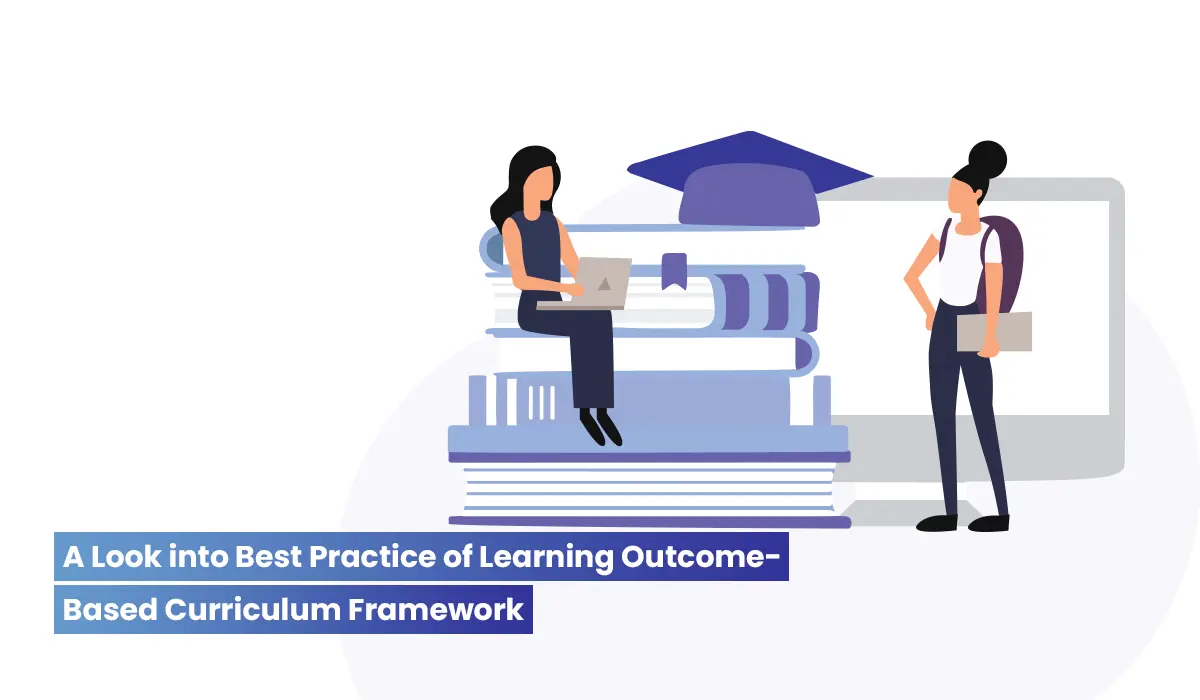The Future of Learning Management System in Higher Education
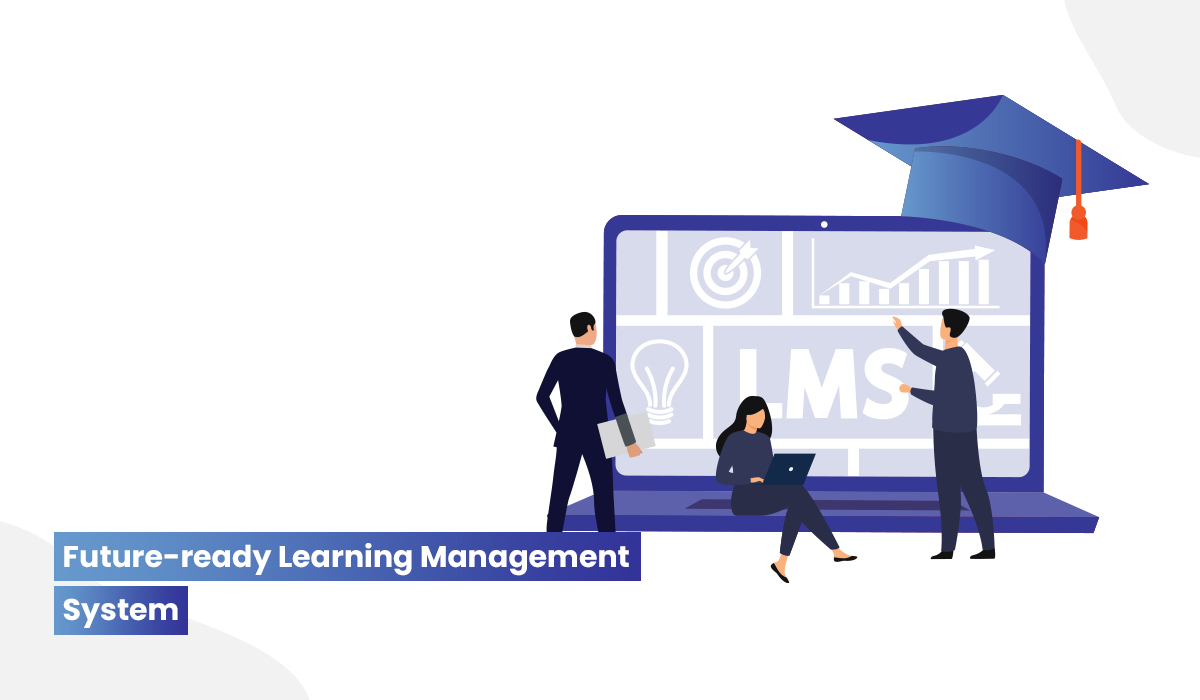
We have come up with many LMS-related blogs so far and this one is the next in the series. The blog covers the readiness and future of Learning Management Systems in the current scheme of COVID-19 and how future-ready a college or university could be by adopting new methods of teaching and collaborating with LMS technology.
The Future of Learning Management Systems LMS
LMS, a Learning Management System is a powerful tool that has become a necessity for every institute in the current scheme of things. Before the internet wave, there was the use of books and libraries. Teachers were the source of information and what they said was the only way of verifying the knowledge people gained a couple of decades back.
With the disruption of technology and its various avatars like the smartphone, social media, personal computers, MOOC, etc. students are not restricted to one kind of information but plenty.
This is also important especially because students have to cope with the rapidly growing and changing scientific and technological advancements in all fields.
So, what kind of solution must an institute possess to make things easier as well as highly usable with so much relevance to the present as well as futuristic goals in mind?
This blog will enhance your perception of Learning Management Systems, what is traditional learning management, its history, and what it can be to make it future-ready.
Everyone knows LMS is a Learning Management System which by definition is, “a software application for the administration, documentation, tracking, reporting, and delivery of educational courses or training programs.” Traditionally, LMS has been used only after the introduction of e-learning and distance learning programs.
What is the history of LMS?
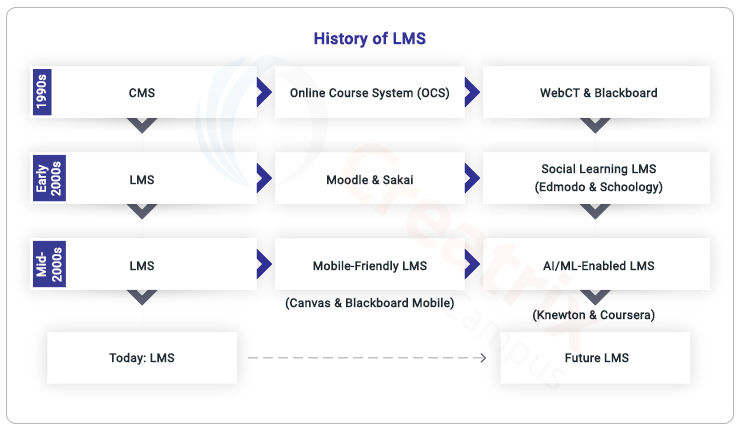
Learning Management System (LMS) has a history that dates back to the early 1990s. It started as a tool for delivering online courses to students in a structured and organized manner. Here's a brief history of LMS:
1990s: The early days of LMS began with the development of Course Management Systems (CMS). One of the first CMS was the Online Course System (OCS), which was created at the University of Illinois. Other notable CMSs during this period were WebCT and Blackboard, which focused on providing a platform for educators to deliver content online.
Early 2000s: As the demand for online education grew, the focus of LMS shifted from content delivery to more robust management systems. This led to the development of more sophisticated LMS, such as Moodle and Sakai. These systems were designed to handle larger class sizes and included features like grade books, discussion forums, and assessment tools.
Mid-2000s: With the rise of social networking sites, LMS started incorporating social learning features like chat rooms and video conferencing. This enabled learners to interact with each other and instructors in real-time. Examples of this type of LMS include Edmodo and Schoology.
Late 2000s: Mobile learning became popular, and LMS started incorporating mobile-friendly features. This allowed learners to access content and engage with instructors from their smartphones or tablets. Examples of this type of LMS include Canvas and Blackboard Mobile.
Today: LMS continues to evolve with the incorporation of artificial intelligence and machine learning. LMS providers are exploring ways to personalize learning, improve course design, and enhance learner engagement. Examples of this type of LMS include Knewton and Coursera.
LMS in the current scenario
An alternative place to learn apart from the classroom, modern LMSs are web-based with cloud hosting options. Facilitators have the option to create, and integrate course materials, spell out their learning goals, map content, and assessments with outcomes, track learning paths, and create customized assessments for a focused learning experience
There are also misconceptions that LMS often leads to minimal student-teacher interaction, loss of specificity, difficulty in adapting to teachers or curriculum, manipulation of the curriculum to meet student needs, and so on.
So what kind of LMS will be future-ready? Only when an LMS solves the above problems. Here are some of the features a future-ready LMS ought to possess to make you battle for an unprecedented future.
Aligns with institutional goals
This is vital that any Learning Management System LMS should align with your institution’s learning goals. LMSs these days come with fun and exciting ways to interact, collaborate, and share with each other.
But the foremost thing to expect from it is its ability to define your learning goals and strategy with your institutional goals. Check this even at the beginning of the LMS implementation project.
AI-powered LMS
An AI-powered LMS offers personalized learning and enhanced automation options.
Personalized Learning
AI LMS has enormous options for personalized learning, outlining an enriched learner journey. Until AI LMS, catering to a customized learning environment digitally was quite challenging.
An AI-powered LMS recommendation engine offers a user-focused UI, with auto filtering of contents suggested to individualized learners gathered by intelligence from user behaviors, skill sets, and information pieces.
This pools out a broad range of related content to its users insightfully without prompting. From a learner’s perspective, there is an increased learner engagement due to this feature where the learner feels that the content is tailored to his knowledge level and requirement.
Enhanced Automation
AI LMS has the ability to automate even the tough human-intervened tasks with its AI algorithm that does content scheduling and delivery processes. Such an LMS understands skill gaps and presents targeted competency mapping and recommendations, taking off the burden from admins manually.
LMS Analytics
Taking learning further in any learning journey is Analytics. Data churned out to track learner preferences, learner satisfaction, learning progress, learner active-ness, to monitor every bit of content consumed, every minute spent, etc.
Analytics in the form of auto-scheduled reports as comparisons, analysis, and conclusions drawn through graphs, and charts can improve content quality, interactiveness, and information structure.
Pedagogy
Pedagogy tools are the eyes and ears of an effective LMS. Most LMSs lack need-based design and integration with curriculum management.
A good LMS must have a design and development tool for the teacher or management to design the course, develop materials, and make it available for the students. It must also have rewards, compensation, and motivation for faculty to teach online.

It is also important to define roles and permission for various roles in an institution. Having an MCQ or Quiz alone won’t be the solution, the LMS must also assign tasks/activities and track those to give defined outcomes that align with the organizational goals.
Gamification
Gamification in LMS has already taken a positive direction in the software industry whether they focus on Higher Education or not. There are many LMS that are being introduced for the purposes of employee growth and individual companies like Google, Hubspot, and Adobe offer gamification in their learning materials.
MOOC platforms like Udemy, Coursera, edX, etc also feature gamification. There are various reasons why gamification in LMS will prove to be a great value addition.
Gamification ensures the learner doesn’t get bored and is always motivated to complete and go to the next levels like in a traditional video game. Features such as Leaderboards, Group boards, etc, invoke a sense of competition among students and encourage them to gain rewards when they achieve their goals.
It also becomes necessary for the institute to not restrict gamification to the LMS alone but also extend it into classrooms and physically involve students in performing activities to improve and test their knowledge.
Collaborativeness
Does the LMS serve as a platform for students and teachers to share knowledge, communicate, give, and receive feedback on topics? It’s already future-ready then! Collaborativeness is an important essence of a Learning Management System.
Futuristic LMS is expected to have web conferencing tools for students to collaborate through seminars, casual collaboration, group meetings, sub-chats, or group chats.
On-demand and pre-planned sessions, efficient course delivery tools, multi-point video, digital whiteboard tools, and application and desktop sharing, promise an ultra learning experience.
Bloom’s Taxonomy Compliance
The Learning Management System that has been developed in the last few decades has evolved more like an e-learning platform and very little as an entire management system.
The MCQs and quizzes conducted on the platform are still testing the lower level of taxonomy and there are not many ways to evaluate a student on the higher levels of the taxonomy.
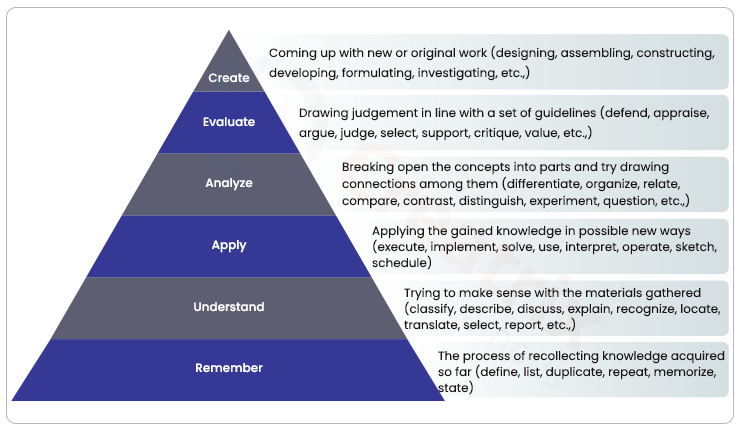
LMS must be able to include tools that would help with higher levels of Bloom’s taxonomy like Applying, Analyzing, Evaluating, and Creating. Only then, the LMS would qualify to offer a complete learning solution and be capable of allowing continuous quality improvement too.
Flipped Learning
Students are tech-savvy these days. Flipped Learning is where the traditional classrooms are flipped from the traditional way and gives an opportunity to students to learn even before they come into the class.
This gives more time in class for students to grasp the concepts, find solutions, practice, and ask for clarifications. Instead of homework, students check their understanding and extend their learning.
A future Learning Management System LMS must be user-friendly and compliant for flipped learning and schedules must be entered into the LMS for better understanding and cooperation from the students.

Flipped Learning is goal-oriented and aligns with the OBE system and allows smooth CQI. LMS aligns with goals and enables Flipped Learning for teachers and students who are going further into deep learning.
LMS Chatbot
LMS AI Chatbot is the shift that revamps the history of virtual education. Chatbots integrated with LMS can create a unique learning experience with a greater level of interactivity and better response capacity much better than in one-on-one training. Thanks to the artificial intelligence algorithm that adapts and personalizes according to each student’s learning capacity.
Blended Learning
LMS Blended learning or hybrid learning gives its users the best of both worlds - classroom learning and e-learning. Such flexibility with mixed support of classroom learning and online education determines the future. Students could access high-quality course materials, course calendars, and assignments at any given time.
Outcome Focused
Imagine an LMS that evaluates performance and qualifies students based on their performances in their outcomes. That is the future of Learning Management Systems LMS.
Outcome-Based Education (OBE) is the industry-wide keyword that is on all maps & charts for higher education.
OBE is to become the standard of learning in the following decade and every institute will want to have accreditation from various governing bodies that allow more acceptance and enrollment of students.
Having an LMS system that integrates with the outcomes, makes it accreditation-friendly, and also serves as a continuous improvement tool for quality is inevitable.
Compliance with Continuous Quality Improvement Infographic:
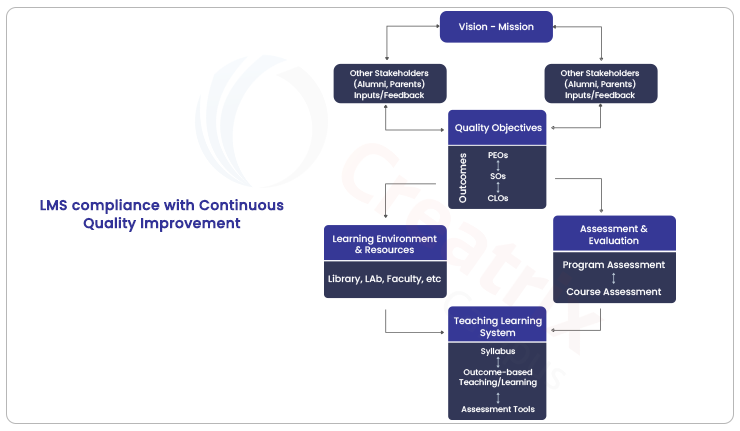
A future Learning Management System LMS will not only do it but check it too, to see if your institute is being compliant with the continuous quality improvement that is required by any accreditation body.
Video Conferencing
Virtual LMSs that easily integrate with external video conferencing platforms including GoToMeeting, WebEx, Google Hangouts, and similar make it future-friendly. This helps conduct remote classes and connect through webinars, at any given time.
Mobile learning
Getting on to mobile has become a necessity. How nice it would be to access learning content through tablets, smartphones, and other mobile devices? Learners teaming up on live sessions via mobile devices and tablets, for on-the-go learning via text chat and audio, assignments submission, instant grading, and replicating a classroom session are already halfway through being future-ready.
Conclusion
Creatrix LMS has all future-ready elements to call it a contemporary, versatile, customizable, and easy-to-use LMS. Every new feature and every bit of the interface is designed to save your time and effort, making teaching and learning easier.
It comes with a rich feature-set for content creation, with key trends including collaborative & engagement tools, self-learning pre-defined assessment elements, flipped/blended learning, outcome-focused, mobile learning, intuitive dashboards that offer insights, LMS analytics predicting reports of various kinds, rich pedagogical tools, etc.
Deploying Creatrix LMS in your institution will surely make you future-ready and prepare you to battle those unpredictable times like the one we are in right now. Request a live demo. Our team would be happy to take you on an in-depth product tour.


